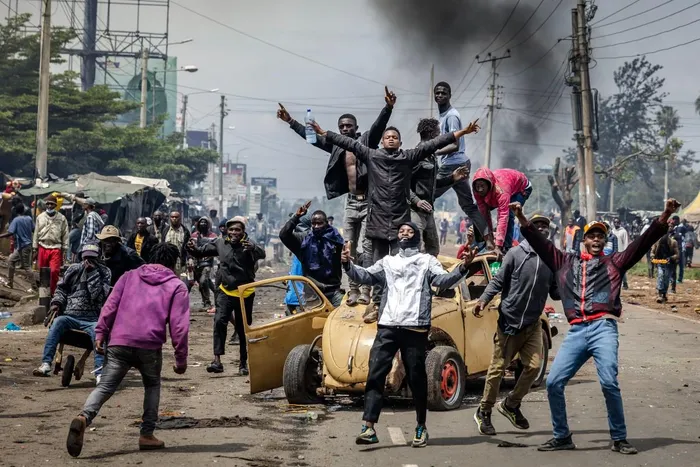Kenyan youth send a clear message to embattled Ruto
EAST AFRICA

PROTESTERS chant anti-government slogans atop a vandalised car used as a barricade to block a road during Saba Saba Day demonstrations in Nairobi on July 7, 2025. Saba Saba Day marks the uprising on July 7, 1990 when Kenyans demanded a return to multi-party democracy after years of autocratic rule by then-president Daniel Arap Moi.
Image: AFP
Dr. Sizo Nkala
Kenya is going through turbulent times. In less than a month, the country has seen two rounds of youth-led anti-government protests on June 25 and July 7.
The first wave of protests, concentrated mainly in the capital, Nairobi, was a commemoration of the deadly June 2024 protests in which young people thronged the streets to express their disapproval of a government-proposed bill to increase taxes. About 60 protesters lost their lives, and scores of others were injured, largely due to a heavy-handed police response.
The protests were effective as the bill was withdrawn, and President William Ruto dismissed his cabinet en masse. The issues at the centre of this year's June protests included police brutality, human rights abuses and government corruption, with some of the protesters calling for the president’s resignation.
Another brutal police response saw 16 protesters lose their lives and around 400 others get injured. The July 7 protests coincided with the 35th anniversary of Saba Saba Day, during which Kenyans commemorate the July 7 1990, protests which forced the Daniel Arap Moi regime to reinstate multi-party politics. The clear message in the choice of the date of the protest is that the Kenyan young people are not impressed by the government’s performance – they want change.
President Ruto has not been a gracious interlocutor in the whole process, which has not gone down well with the youth. In June, he mockingly and arrogantly asked the protesters where they wanted him to go in response to the #RutoMustGo, which was trending on social media. After the Saba Saba demonstrations, Ruto recklessly ordered the police to shoot any unruly demonstrators in the leg to incapacitate them.
His comments drew widespread criticism from human rights and civil society organisations, who have accused the security forces of criminalising demonstrations and abusing human rights. It is increasingly looking like President Ruto is destined to be a one-term president if the anti-government sentiment is sustained and used to mobilise the youth to go and vote in the next presidential elections in two years.
There have also been allegations that state security agents have abducted and tortured tens of young people around the country who have been using their social media profiles to lend support to the demonstrations. In a further display of its intolerance of the protests, the Kenyan government issued a chilling warning to media outlets against covering the protests.
This was a brazen and blatant affront to constitutionally protected rights to freedom of speech and information.The Kenyan youth are not just throwing a tantrum for the sake of it. They have a case. In a 2025 Afrobarometer survey, 62 per cent of those aged 18-35 years said they were not employed, with 19 per cent indicating that they had given up looking for work. With this age group making up 36 per cent of the population, such levels of discontent are a threat to national security.
As a result, many of the young people are trapped in low-skill, low-pay and informal self-employed roles where they are struggling to survive. The World Bank estimates that there will be almost 23 million Kenyans aged 15-35 years by 2030. This presents a ticking time bomb if the government does not address the unemployment crisis with a sense of urgency.
Almost 34 per cent of the population lives below the US$2.15 a day poverty line. With a Gini index of over 38 per cent, Kenya also struggles with high levels of unequal wealth and income distribution. It is a country of two worlds. The abject poverty at the bottom stands in stark contrast to opulence and massive wealth at the top.
While Kenya’s 23-member cabinet has a staggering per capita net worth of US$6.3 million, the country’s GDP per capita is about US$2,000. As such, there exists a wide berth in terms of worldviews and interests between Kenya’s governing class and the governed masses. According to the Corruption Perceptions Index (CPI) of 2024, Kenya is the 121st least corrupt country out of 180 countries. Corruption has become ingrained in the public sector, where public officers engage in rampant rent-seeking while the political elite compete for fat government contracts.
In a 2022 National Ethics and Corruption Survey, a shocking 64 per cent of the participants reported having paid a bribe for access to public services, including getting a business licence, healthcare or seeking police attention.
Hence, reeking of corruption and incompetence, the Kenyan government is not fit for purpose. It is a little more than an instrument of primitive accumulation by the country’s elite. Without substantive reforms, demonstrations and protests will only intensify.
The last thing East Africa, and indeed the whole of Africa, needs is an unstable Kenya. It is important that the Kenyan leaders take the concerns and grievances of the youth seriously to avoid the horrors of political instability.
* Dr. Sizo Nkala is a Research Fellow at the University of Johannesburg’s Centre for Africa-China Studies.
** The views expressed do not necessarily reflect the views of IOL, Independent Media or The African.